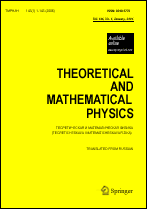|
This article is cited in 6 scientific papers (total in 6 papers)
Diagrammatic theory for the Anderson impurity model: Stationary property of the thermodynamic potential
V. A. Moskalenkoab, P. Entelc, L. A. Dohotarud, R. Citroe
a Joint Institute for Nuclear Research
b Institute of Applied Physics Academy of Sciences of Moldova
c University of Duisburg-Essen
d Technical University of Moldova
e Dipartimento di Fisica "E. R. Caianiello", Università degli Studi di Salerno
Abstract:
We propose a diagrammatic theory around the atomic limit for the normal state of the Anderson impurity model. The new diagram method is based on Wick's theorem for conduction electrons and a generalized Wick's theorem for strongly correlated impurity electrons, which coincides with the definition of the Kubo cumulant. We prove a linked-cluster theorem for the mean of the evolution operator and obtain Dyson-type equations for the one-particle propagators. The main element in these equations is the impurity electron correlation function, which contains the spin, charge, and pairing fluctuations of the system. We express the system thermodynamic potential in terms of the full propagator of conduction electrons and the correlation function. We establish that the thermodynamic potential is stationary under changes of the correlation function.
Keywords:
strongly correlated electron system, Dyson equation, Green's function, Anderson impurity model.
Received: 02.08.2008
Citation:
V. A. Moskalenko, P. Entel, L. A. Dohotaru, R. Citro, “Diagrammatic theory for the Anderson impurity model: Stationary property of the thermodynamic potential”, TMF, 159:1 (2009), 162–173; Theoret. and Math. Phys., 159:1 (2009), 551–560
Linking options:
https://www.mathnet.ru/eng/tmf6339https://doi.org/10.4213/tmf6339 https://www.mathnet.ru/eng/tmf/v159/i1/p162
|


| Statistics & downloads: |
| Abstract page: | 529 | | Full-text PDF : | 248 | | References: | 58 | | First page: | 5 |
|




 Contact us:
Contact us: Terms of Use
Terms of Use
 Registration to the website
Registration to the website Logotypes
Logotypes








 Citation in format
Citation in format 
